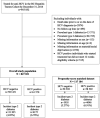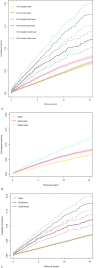Impact of HCV infection and ethnicity on incident type 2 diabetes: findings from a large population-based cohort in British Columbia
- PMID: 34099439
- PMCID: PMC8186745
- DOI: 10.1136/bmjdrc-2021-002145
Impact of HCV infection and ethnicity on incident type 2 diabetes: findings from a large population-based cohort in British Columbia
Abstract
Introduction: Increasing evidence indicates that chronic hepatitis C virus (HCV) infection is associated with higher risk of diabetes. Previous studies showed ethnic disparities in the disease burden of diabetes, with increased risk in Asian population. We described the incidence of type 2 diabetes related to HCV infection and assessed the concurrent impact of HCV infection and ethnicity on the risk of diabetes.
Research design and methods: In British Columbia Hepatitis Testers Cohort, individuals were followed from HCV diagnosis to the earliest of (1) incident type 2 diabetes, (2) death or (3) end of the study (December 31, 2015). Study population included 847 021 people. Diabetes incidence rates in people with and without HCV were computed. Propensity scores (PS) analysis was used to assess the impact of HCV infection on newly acquired diabetes. PS-matched dataset included 117 184 people. We used Fine and Gray multivariable subdistributional hazards models to assess the effect of HCV and ethnicity on diabetes while adjusting for confounders and competing risks.
Results: Diabetes incidence rates were higher among people with HCV infection than those without. The highest diabetes incidence rate was in South Asians with HCV (14.7/1000 person-years, 95% CI 12.87 to 16.78). Compared with Others, South Asians with and without HCV and East Asians with HCV had a greater risk of diabetes. In the multivariable stratified analysis, HCV infection was associated with increased diabetes risk in all subgroups: East Asians, adjusted HR (aHR) 3.07 (95% CI 2.43 to 3.88); South Asians, aHR 2.62 (95% CI 2.10 to 3.26); and Others, aHR 2.28 (95% CI 2.15 to 2.42).
Conclusions: In a large population-based linked administrative health data, HCV infection was associated with higher diabetes risk, with a greater relative impact in East Asians. South Asians had the highest risk of diabetes. These findings highlight the need for care and screening for HCV-related chronic diseases such as type 2 diabetes among people affected by HCV.
Keywords: HCV infection; epidemiology; ethnicity; longitudinal studies.
© Author(s) (or their employer(s)) 2021. Re-use permitted under CC BY-NC. No commercial re-use. See rights and permissions. Published by BMJ.
Conflict of interest statement
Competing interests: DJ is supported by the CIHR Frederick Banting and Charles Best Doctoral Award and the Canadian Network on Hepatitis C PhD fellowship. MEK is supported by the Michael Smith Foundation for Health Research Scholar award and holds research grants from the Natural Sciences and Engineering Research Council of Canada and BC SUPPORT Unit. Over the past 3 years, MEK has received consulting fees from Biogen (unrelated to this project). MK has received grant/research support from Roche, Merck, Siemens, Boehringer Ingelheim and Hologic. SW, JW, ZAB, MB, PAA, SB, MP, EC, AY, MA, HS, HAVG, YA and NZJ have no conflicts of interest to declare.
Figures


References
Publication types
MeSH terms
Grants and funding
LinkOut - more resources
Full Text Sources
Medical
